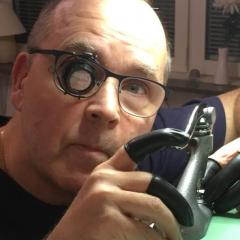Unknown Balance Jewel Setting
-
Recently Browsing
- No registered users viewing this page.
-
Topics
-
Posts
-
By ColChibani · Posted
Actually, I finally did both. I bought a digital caliper that measured 0.9 mm for the screws. And I bought a spare movement, without case, but with both clamps & screws. It will arrive in a few weeks. And, when searching for these screws, I found exactly the same russian watch I am trying to repair, in good condition, and for a bargain price (see photo). I bought it as well, but I will repair the other one anyway. The travel is the journey ! I keep going ... -
See blued srews on a genuine Rolex (Fig. 12): http://people.timezone.com/mdisher/andrewb/3135/3135_1.htm and here: https://www.chrono24.de/rolex/werk-komplett-rolex-3135---complete-movement--calibre-3135---genuine-rolex---fully-working--id29910928.htm
-
That's what I'm hoping and believe, and why I wanted to discuss it with you. No, I'm being dead serious! What made you think I was kidding? It's a sincere question. What puzzles me is that only the top of the screw head is blued (see image in my previous post or below). Not even the screw slot is blued! In my opinion, it looks "Chinese-cheap" and not what I would associate with Rolex. Hence, it awakened my suspicion that something might be wrong. Neither have I! I never paid much attention to all of those videos on YouTube explaining how to tell a fake and genuine Rolex movement apart, as I thought the escapement would be a dead giveaway. After all, who would be willing to pay for a fake free sprung balance with a Breguet hairspring and micro stella regulation, and having the insane precision that a genuine Rolex 3135 has? Looking at the timing machine results (my first post), I had no doubt whatsoever that I was dealing with the real McCoy. So @rehajm, are you telling us we're looking at a fake Rolex free sprung balance with a Breguet hairspring, micro stella regulation and KIF shock protection? If so, we were wrong to assume that we would never see that in a Chinese clone. Ay caramba! 😱 So, what's the giveaway? I get your point, John. It makes zero sense! But did you notice how both the original eBay screws and the generic screws are completely blued. The ones I found to hold the date indicator seating in place were only partly blued? Let me show you the picture again: Makes you wonder if the Rolex screwmaker had a bad day or didn't understand the specification, as it was not written in Mandarin. So, what's the verdict? Am I dealing with a genuine Rolex 3135 or a Chinese super clone? If you don't know or you're not sure, please feel free to take a guess! Here is a link to the first 100 pictures I've taken during the disassembly: https://1drv.ms/f/c/5643825a9f286b75/EpbF5n_qRCREvohfgbcZ4l4B0eUcw2h62xqmPYtdPzQ-QA?e=QIwcN0
-
They can go over, under, or around (fork shaped) depending on the movement. You can see all types in the following thread, where I was asking how to support the pinion when fitting the seconds hand when the spring sits on top of the pinion (on a Longines 30LS).
-
Servicing another Navitimer for a work colleague (again, I suggested he get it done professionally), this one relatively new. It has an ETA base movement with a DD chrono module bolted on. I've serviced the base movement and it's all running well. The chrono module is another story! I've done a DD module before, but this one is a little different. I'm struggling to get the stop-start function to work. I can see what it's meant to do, but it's not doing it. Any clues? Image 1 shows it in the stopped position, highlighting the area of interest image 2 is a close up showing how the arms should move when the pusher is activated. Image 3 shows what happens - the cam moves, but the lower arm doesn't pick up the post on the pusher lever. I've highlighted what should have happened and image 4 shows it in the correct running position with the post engaged with the lower arm ready to stop. Image 5 shows what happens after pushing again - the post should be picked up by the upper arm but it isn't. Some parts aren't in place, but I don't think I've removed any that assist in the stop start. And excuse the greasy mess - if I ever figure out what's wrong I'll put it through the wash again before final reassembly. Could the return springs be the issue? The clothes-peg shaped one between the two arms is in the right place as far as I know, but seems weak. And the operating level return spring is there too but again seems weak. Thanks in advance for any suggestions
-




Recommended Posts
Join the conversation
You can post now and register later. If you have an account, sign in now to post with your account.
Note: Your post will require moderator approval before it will be visible.